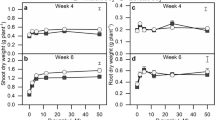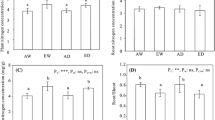Summary
Lucerne, red clover and white clover were grown at two atmospheric concentrations of CO2 (300 and 1000 μl l−1) and the effects on N2 fixation, nodule mass/number and root/shoot dry matter production determined. Pea plants were similarly evaluated as a comparison with grain legumes. CO2 enrichment increased N2 fixation activity in all cases but activity/unit nodule mass was significantly increased only in the pea. The enhancement of N2 fixation in herbage legumes by CO2 enrichment reflected an increase in nodule mass which in turn was attributed to increased nodule number, and results show that under the experimental conditions obtaining here photosynthate supply did not limit nodule N2 fixation in these plants though it was limiting in the case of peas.
White clover growing in a 6 and 14 hour photoperiod was studied for response of the N2 fixing system to light. Long photoperiod (14 hour) plants assayed at constant temperature (20°C) did not show a significant response to light at the end of the dark period either in terms of fixation per plant or per unit nodule mass, in contrast with short photoperiod (6 hour) plants which showed significant responses. Short photoperiod plants compensated for reduced photosynthates by maintaining only half the root nodule mass and fixation activity of 14 hour photoperiod plants though plants in both systems supported similar rates of N2 fixation per unit mass of nodule during the photoperiod. Comparison of N2 fixation activities in whole and decapitated plant systems indicates the importance of shoot reserves for sustaining nitrogenase activity in white clover during short-term interruption of photosynthesis. These results support the conclusion of the CO2 enrichment studies, that herbage legumes have the potential for supplying their nodule photosynthate requirements for sustaining optimum rates of N2 fixation and excess carbon supply is used solely to promote further nodulation.
Nodules of short photoperiod white clover plants were less efficient in N2 fixation in that they evolved more H2 relative to N2 (C2H2) reduced than did long photoperiod plants.
Similar content being viewed by others
References
Allison F E 1935 Carbohydrate supply as a primary factor in legume symbiosis. Soil Science 39, 123–143.
Bethlenfalvay G J and Phillips D A 1979 Variation in nitrogenase and hydrogenase activity in Alaska pea root nodules. Pl. Physiol. 63, 816–820.
Carran R A, Rumball P J, Tough H J, Brock J L and Crush J R 1982 Diurnal variation in acetylene reduction by white clover. New Zealand J. Agric. Res. 25, 295–299.
Crush J R and Tough H J 1981 Hydrogen evolution from white clover. New Zealand J. Agric. Res. 24, 365–370.
Dixon R O D 1978 Nitrogenase-Hydrogenase interrelationships in Rhizobia. Biochimie 60, 233–236.
Fred E B and Wilson P W 1934 On photosynthesis and free nitrogen assimilation by leguminous crops. Proc. Nat. Acad. Sci. USA. 20, 404–409.
Georgi C E 1935 Influence of the carbohydrate-nitrogen relation on nodule production by red clover. J. Agric. Res. 51, 597–612.
Gibson A H, Dreyfus B L, Lawn R J, Sprent J I and Turner G L 1981 Host and environmental factors affecting hydrogen evolution and uptake.In Current Perspectives in Nitrogen Fixation. Eds. A H Gibson and W E Newton. p. 373. Australian Academy of Science, Canberra.
Halliday J and Pate J S 1976 The acetylene reduction assay as a means of studying nitrogen fixation in white clover under sward and laboratory conditions. J. Br. Grassl. Soc. 31, 29–35.
Hardy R W F and Havelka U D 1976 Photosynthate as a major factor limiting nitrogen fixation by field-grown legumes with emphasis on soybeans.In Symbiotic Nitrogen Fixation in Plants. Ed. P S Nutman. pp 421–439. Cambridge Univ. Press.
Haystead A, King J and Lamb W I C 1979 Photosynthesis, respiration and nitrogen fixation in white clover. Grass and Forage Science, 34, 125–130.
Hosoda N, Lee K K and Yatazawa M 1978 Effects of carbon dioxide, oxygen and light on nitrogen-fixing activities in Japan clover (Kummerowia striata S.) Soil Sci. Plant Nutr. 24, 113–119.
Kelly M 1969 Some properties of purified nitrogenase ofAzotobacter chroococcum. Biochim. Biophys. Acta. 171, 9–22.
Lawn R J and Brun W A 1974 Symbiotic nitrogen fixation in soybeans 1. Effect of photosynthetic source-sink manipulations. Crop. Sci. 14, 11–16.
La Favre J S and Focht D D 1983 Conservation in soil of H2 liberated from N2 fixation by hup− nodules. Appl. Environ. Microbiol. 46, 304–311.
Masterson C L and Sherwood M T 1978 Some effects of increased atmospheric carbon dioxide on white clover (Trifolium repens) and pea (Pisum sativum). Plant and Soil 49, 421–426.
Masterson C L and Murphy P M 1979 The acetylene reduction technique.In Recent Advances in Biological Nitrogen Fixation. Ed. N S Subba Rao. pp. 4–33. Oxford and IBH Publishing Co.
Phillips D A, Newel K D, Hassell S A and Felling C E 1976 The effect of CO2 enrichment on root nodule development and symbiotic N2 reduction inPisum sativum L. Am. J. Bot. 63, 356–362.
Popelier F, Liessens J and Verstraete W 1985 Soil H2-uptake in relation to soil properties and rhizobial H2 production. Plant and Soil 85, 85–96.
Ruiz-Argueso T, Maier R J and Evans H J 1979 Hydrogen evolution from alfalfa and clover nodules and hydrogen uptake by free-livingRhizobium meliloti. Appl. Environ. Microbiol 37, 582–587.
Ryle G J A, Powell C E and Gordon A J 1985 Short-term changes in CO2 evolution associated with nitrogenase activity in white clover in response to defoliation and photosynthesis. J. Exp. Bot. 36, 634–643.
Schubert K R and Evans H J 1976 Hydrogen evolution: a major factor affecting the efficiency of nitrogen fixation in nodulated symbionts. Proc. Nat. Acad. Sci. USA. 73, 1207–1211.
Smith D 1969 Removing and analysing total nonstructural carbohydrate from plant tissue. Research report 41, College of Agric. Life Sci. Univ. Wisconsin Madison.
Sprent J I 1979 Nitrogen fixation and agriculture.In The Biology of Nitrogen-fixing Organisms. McGraw-Hill (UK). pp 75–113.
Stewart W D P, Fitzgerald G P and Burris R H 1967In situ studies on N2 fixation using the acetylene reduction technique. Proc. Nat. Acad. Sci. USA. 58, 2071–2078.
Wilson P W, Fred E B and Salmon M R 1933 Relation between carbon dioxide and elemental nitrogen assimilation in leguminous plants. Soil Science 35, 145–165.
Wilson P W 1935 The carbohydrate-nitrogen relation in symbiotic nitrogen fixation. Research Bulletin 129. Agric. Exp. Sta. Univ. Wisconsin, Madison.
Author information
Authors and Affiliations
Rights and permissions
About this article
Cite this article
Murphy, P.M. Effect of light and atmospheric carbon dioxide concentration on nitrogen fixation by herbage legumes. Plant Soil 95, 399–409 (1986). https://doi.org/10.1007/BF02374620
Received:
Revised:
Issue Date:
DOI: https://doi.org/10.1007/BF02374620




